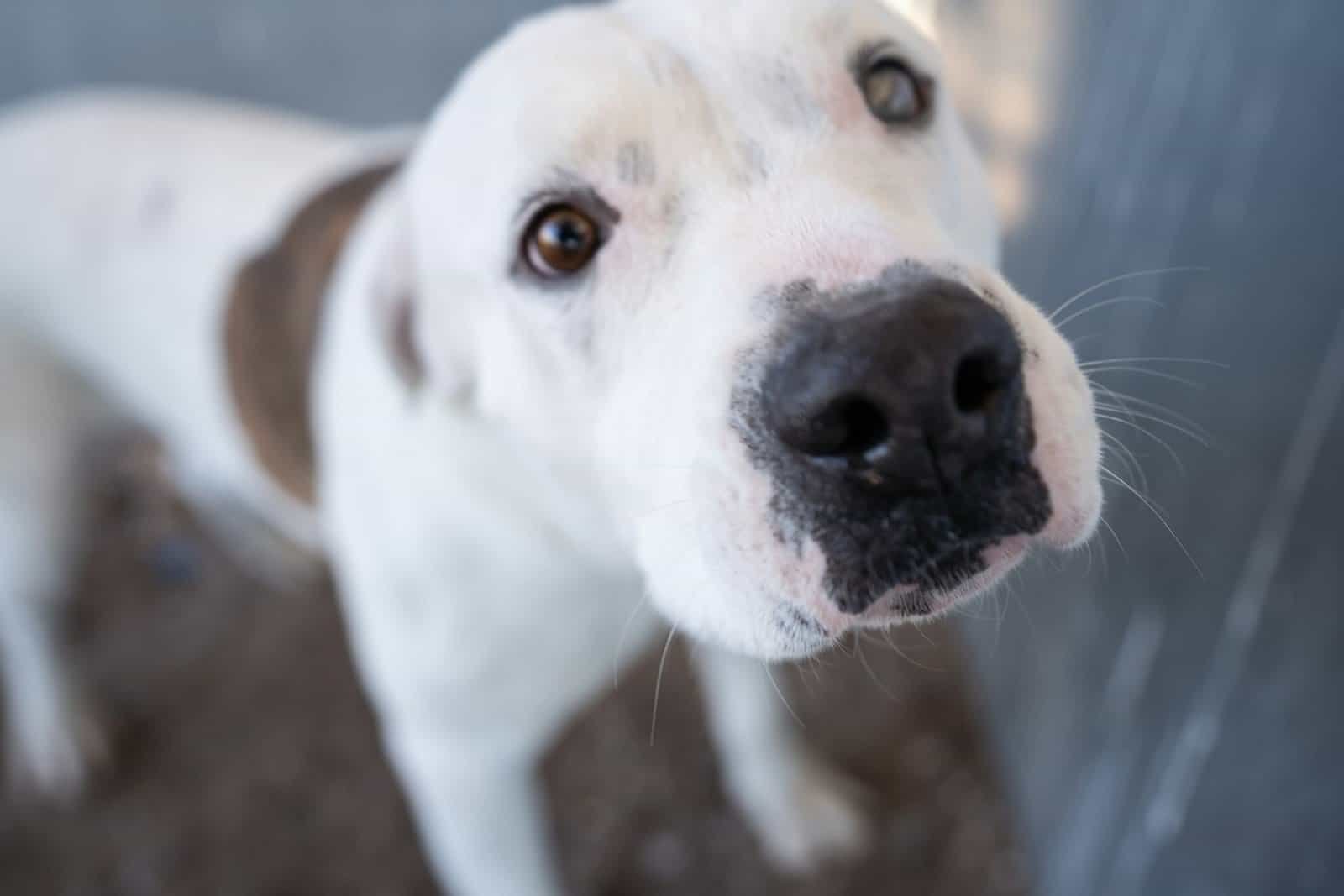
From Our Experience: As poodle enthusiasts who have worked with hundreds of poodle owners and rescue organizations over the years, we’ve gathered real-world insights that go beyond textbook knowledge. The information in this article reflects both professional expertise and hands-on experience with poodles of all sizes and temperaments.
Understanding Rescue Dogs
Rescue dogs usually come from tough backgrounds. Dedicated rescue organizations give them a second chance at a better life.
Many dogs end up in rescues because of things outside their control. Family changes, abandonment, or mistreatment can all lead to rehoming.
What Are Rescue Dogs
A rescue dog is a dog removed from a harmful or unsuitable situation and placed with a rescue or shelter. These dogs come in all ages, breeds, and backgrounds, but they all want a safe home.
Dogs in rescue care might be strays, pets given up by owners, or animals rescued from neglect. Some people think rescue dogs have more issues, but most just need patience and kindness as they settle in.
Rescue dogs can be just as loving and loyal as any dog from a breeder. Healthwise, they’re often just as good, too.
Adopting a rescue dog can save two lives: the one you take home and the one who gets their spot in the rescue. The Ark Pets explains this ripple effect.
Types of Rescue Organizations
There are lots of rescue organizations, and each has its own focus. Some are public animal shelters run by local government, open to all breeds and sizes.
Others are nonprofit rescues, usually run by volunteers. These might focus on a specific breed, age, or special need.
Breed-specific rescues work to rehome certain types, like Golden Retrievers or Greyhounds. Foster-based rescues rely on people to house dogs temporarily.
No-kill shelters promise to only euthanize animals who are too sick or unsafe to place with families. Many groups work together, moving dogs from crowded shelters to places with more adopters.
Dogs sometimes travel across states or even countries through these networks. It’s a big, connected effort.
Common Reasons Dogs Need Rescue
Dogs end up needing rescue for all sorts of reasons. One of the most common is owner surrender.
Families might move, face money problems, or deal with health issues. Sometimes, pets just can’t come along.
Some dogs get lost or are found as strays. Others are rescued from neglect or abuse.
Authorities, neighbors, or animal control can step in when dogs are in danger. Occasionally, breeders or puppy mills shut down and send many dogs into rescue care.
Natural disasters like floods or fires can separate pets from families. Rescue groups jump in during these emergencies.
Adopting a rescue dog is more common now as people care more about animal welfare.
Rescue Dog Adoption Process
Adopting a rescue dog involves a few main steps. You’ll start with finding the right group and end with bringing your new friend home.
It helps to know what to expect, like the steps to adopt, how to match with a dog, important policies, and where local adoption events happen.
Steps to Adopt a Rescue Dog
The adoption process usually starts with some research. People look up trustworthy rescues or shelters nearby.
Most groups post adoptable dogs on their websites. Next comes filling out an application, which asks for basic info and details about your home.
Some rescues set up an interview or home visit. They want to make sure the dog will be safe and loved.
Once you’re approved, you can meet different dogs to see who fits best. Adoption fees usually cover vet care, shots, spay or neuter, and microchipping.
Shelters or rescues often explain the process clearly. For a full breakdown, check this step-by-step guide to adopting a dog.
Finding the Perfect Match
Every rescue dog is unique. Rescues work to find a good fit between the dog and the adopter.
A strong match helps create a lasting bond. Rescue workers will ask about your lifestyle, work hours, kids, other pets, and your experience with dogs.
They might offer suggestions based on your answers. Meeting dogs in person or through videos can help you choose.
Trying out time with different dogs is common. Shelters want you to feel confident before making it official.
Adoption Requirements and Policies
Adoption agencies have rules to protect both pets and people. Most require an application, proof of age (usually 18+), photo ID, and landlord approval if you rent.
Dogs are vaccinated and get basic medical care before adoption. Many rescues want everyone in the home to meet the dog.
Some groups ask for a home visit to check for safety. Policies vary, so it’s worth asking questions and reading the fine print.
Dogs aren’t always adopted out first-come, first-served. Shelters try to find the best, most stable homes.
You can read more about adoption policies and what to expect.
Adoption Events
Adoption events are a great way to meet rescue dogs face-to-face. These usually happen at pet stores, parks, or community centers.
Shelters and rescues bring several dogs for people to meet. Events can speed up the matching process and let you ask questions in person.
Some events even have on-the-spot interviews or instant adoption approval if you’re ready. Dogs get more visibility at these gatherings, which means more chances for them to find homes.
You can see all sorts of breeds, sizes, and ages. Local rescues usually post event details on their websites or social media.
Curious about how these events work? Check out this guide to adoption events.
Fostering Rescue Dogs
Foster homes give rescue dogs a safe place and daily care while they wait for adoption. Fostering helps dogs, rescuers, and foster families, and it’s a big part of reducing shelter crowding.
Role of Foster Homes
Foster homes are temporary shelters for rescue dogs who can’t stay in regular shelters. Many foster-based rescues don’t have buildings at all—they rely entirely on fosters.
Foster homes give safety, attention, socialization, and patience. Dogs can recover from stress or injury in a home setting.
Fosters learn each dog’s quirks and can help with training or new routines. This makes it easier for dogs to settle into permanent homes.
Foster families share info about a dog’s behavior and preferences, helping rescues match them with the right adopter. Organizations like Little Dog Rescue and foster teams in places like Tokyo depend on regular families to help out.
How to Become a Foster
If you want to foster, start by reaching out to a local rescue or shelter. Most have online applications or forms.
The process usually includes an interview, a home check, and some basic training or guidelines. If you rent, you’ll need landlord approval.
Rescues often match fosters with dogs that fit their experience or lifestyle. For example, families with kids might get dogs that do well in busy homes.
Support is usually provided—supplies, vet care, and advice. This guide to animal shelters in Tokyo has more info on getting started.
Benefits of Fostering
Fostering is rewarding for both people and dogs. Dogs in foster care adjust to home life and pick up new habits, which boosts their chances of adoption.
Shelters can help more dogs when fosters open up their homes. Fosters often form close bonds and feel good knowing they gave a dog a second chance.
Caring for a rescue dog can help shy or scared dogs gain confidence. Adopt a Pet says foster-based rescues see healthier, happier dogs compared to those in kennels.
Fostering is also a way to enjoy a pet and help your community, all without a long-term commitment.
Supporting Foster-Based Rescues
Foster-based rescues need support from the community. Even if you can’t foster, you can help in other ways.
Donating supplies, volunteering at events, or sharing posts online all make a difference. Many rescues host adoption or fundraising events to connect and find new fosters.
You can help with admin work, transport, or social media. Every bit helps foster networks save more dogs.
Sites like Lil Rascals Dog Rescue share foster stories and offer ways to get involved. Strong community support means more dogs leave shelters and find real homes.
How Rescue Organizations Operate
Rescue organizations use a structured approach to save at-risk dogs and get them into safe homes. They rely on teamwork, volunteers, and support from donations.
Structure of Rescue Groups
Most dog rescue groups are non-profits with small staffs. Volunteers handle daily care, transport, and fostering.
Here’s how it usually breaks down:
- Board of Directors: Handles big-picture decisions and planning.
- Staff: Manages daily operations and programs.
- Foster Families: Provide temporary homes until adoption.
- Partners and Shelters: Offer backup and extra support.
Dogs come into rescue through shelters or owner surrenders. Organizations coordinate medical treatment, rehab, and foster placement.
Many groups team up with local shelters or join bigger networks to save more dogs. Loves Dogs talks more about these partnerships.
Volunteer Involvement
Volunteers are the backbone of most rescues. They take on everything from dog care and foster parenting to transport, fundraising, and event planning.
Many groups depend on a wide network of committed supporters. These helpers make it possible for dogs to have safe homes, exercise, and medical care.
Some volunteers foster dogs full time until adoption. Others pitch in at events or help with online fundraising.
Every hour given makes a direct difference for the animals, as Pupford shows. Most rescues offer training, so you don’t need special experience to get started.
Examples of volunteer roles:
- Foster care
- Dog walking
- Administrative help
- Outreach and advocacy
Funding and Donations
Running a rescue organization costs a lot. Adoption fees help, but they only cover part of the expenses.
Most groups rely on supporters and donations for supplies, food, medical bills, and transport, as Worthy Dog Rescue describes.
Common funding sources:
- Individual Donors: People who give money, supplies, or services.
- Fundraising Events: Auctions, pet adoption days, online drives.
- Grants: Funds from animal welfare groups or foundations.
- Corporate Sponsors: Businesses that donate goods or money.
Monthly or one-time gifts let organizations pay for emergency care, shelter fees, and unique needs for each dog. Even a small donation can add up and make a difference.
Saving Dogs and Reducing Euthanasia Rates
Every year, thousands of dogs face euthanasia in animal shelters across the United States. Rescue organizations step in and give these animals a second chance by pulling them from overcrowded shelters and finding them homes.
The Impact of Rescue on Euthanasia
Rescue groups lead efforts to save lives that might otherwise be lost. Many focus on pulling dogs from shelters that are over capacity or have high euthanasia rates.
By doing this, they save individual dogs and open up space for other animals to get adopted. Moving dogs from high-risk areas to regions with better adoption possibilities has shown results.
Some teams work with programs like service dog training, matching rescued dogs with people in need, such as veterans with PTSD. This model helps both the dog and the community.
Partnerships with local businesses and nonprofits can bring in funding and support, which helps keep these life-saving efforts going.
How Rescues Save Lives
Rescues use several proven ways to reduce euthanasia and save more dogs:
- Fostering: Foster families let rescues save more dogs than traditional shelters can hold.
- Transport: Some groups fly or drive dogs to no-kill shelters or sanctuaries in other regions, where adoption demand is higher.
- Training: Obedience or service dog training programs, sometimes with help from inmates or community groups, boost a dog’s adoption chances.
- Adoption Events: Regular events raise visibility and help more dogs find homes.
- Community Outreach: Rescues educate the public about responsible ownership, spaying and neutering, and ways to keep animals out of shelters.
These combined methods give many dogs a new start.
Current Euthanasia Rates
The U.S. still has a high euthanasia rate, though things have improved compared to past decades. In some places, overcrowded shelters have to make tough choices when they run out of space.
Rescue groups help lower these numbers by moving dogs to areas with more adopters. Pit Bulls, for example, make up a large portion of shelter intake—sometimes 30-40%—and often have lower adoption rates.
The “no-kill” movement has helped reduce euthanasia in many regions by promoting adoption, expanding spay and neuter programs, and building stronger community support. Many lives are saved, but there are still challenges in places with fewer resources or high shelter intake.
Training and Rehabilitation
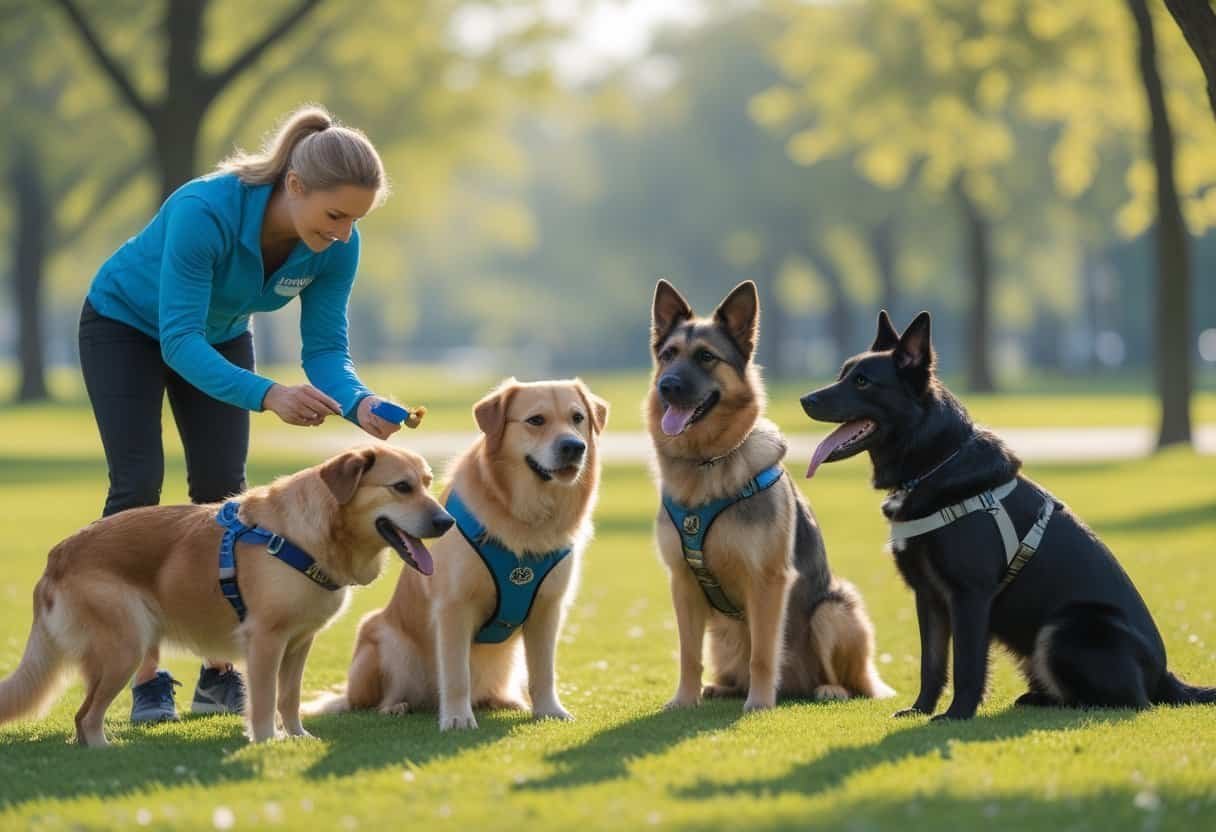
Rescue dogs often arrive with uncertainty, fear, or tough behaviors after trauma or neglect. Good training plans, careful evaluations, and tailored rehab help them become adoptable pets.
Behavioral Assessment
A behavioral assessment is the first step for a dog needing support. Trained professionals watch how the dog reacts to people, other animals, and new environments.
They note signs of fear, aggression, or extreme shyness. Assessment tools might include checklists or just observing during play, feeding, or calm times.
Spotting specific triggers is key. For example, a dog spooked by loud noises might need a quiet space at first.
Rescue groups often bring in experienced trainers for these evaluations. That way, each dog gets a care plan focused on its unique needs.
Training Rescue Dogs
Training gives rescue dogs structure, boundaries, and skills for daily life. Positive reinforcement—treats, praise, you name it—helps build trust.
Programs focus on basic commands like sit, stay, and come. Dogs may also learn leash walking, crate training, and social manners.
Keeping routines consistent reduces anxiety and helps dogs feel secure. Some organizations, including Training Rescue Dogs, Inc., hire skilled trainers for each dog.
Their goal? Turn tough cases into well-mannered companions ready for family life.
Rehabilitation for Special Needs
Some rescue dogs need extra help because of past neglect, trauma, or medical issues. Rehab might involve behavior modification, special exercise, or medical treatment.
Trainers use gentle, science-based methods to help dogs with fear or aggression, as Rehab Your Rescue outlines. Patience and repetition help dogs accept new experiences.
Sometimes, a dog needs therapy for anxiety or help from assistive devices. The right plan supports each dog’s well-being and boosts their chance at a loving home.
Improving Quality of Life for Rescue Dogs
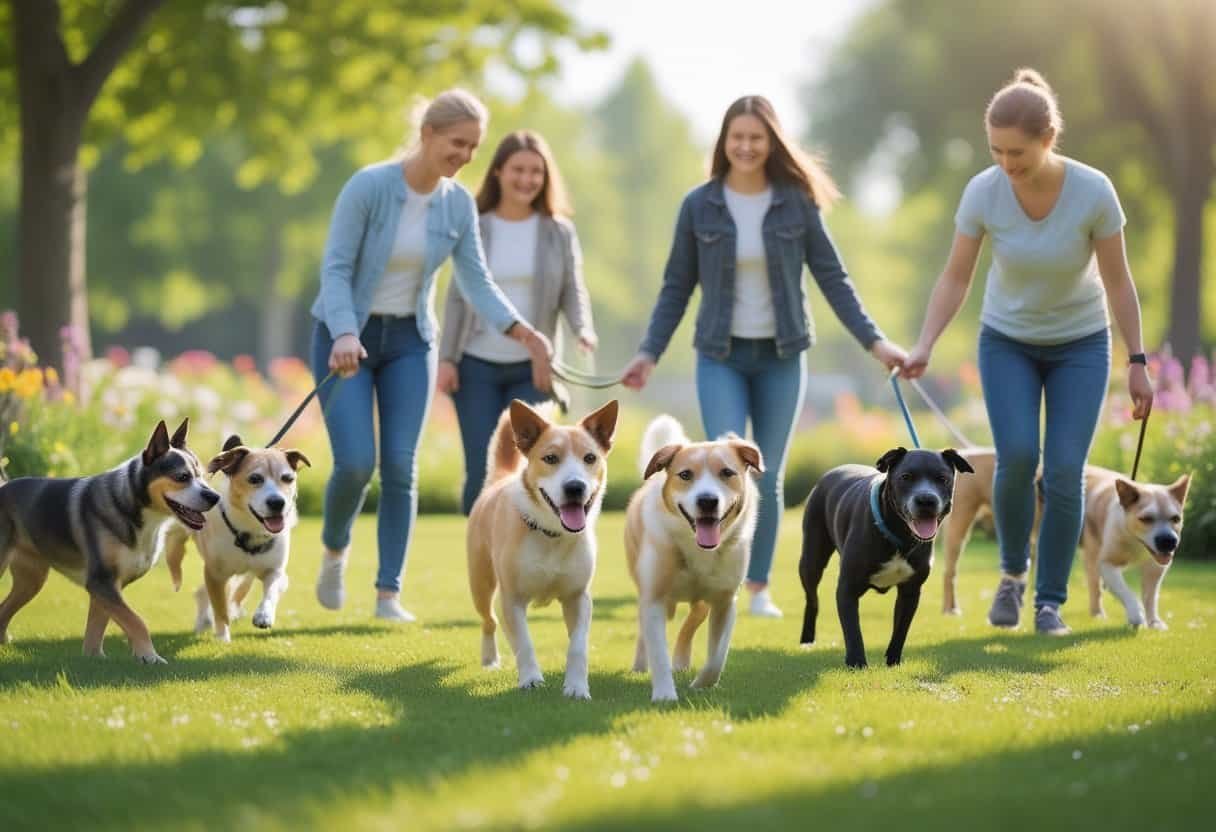
Meeting rescue dogs’ needs means focusing on both their emotional happiness and physical health. Giving them a stable, loving place to live helps them settle in and grow.
Ensuring Happiness and Well-Being
Rescue dogs need good food, shelter, and medical care for a decent quality of life. Regular health checks and vaccines keep them safe from common diseases.
Dogs need clean spaces, fresh water, and cozy beds to feel secure. Routine exercise—daily walks and playtime—supports both mental happiness and physical wellness.
Training sessions help dogs learn good behaviors and build trust with people. Using positive reinforcement and patience, handlers and volunteers can reduce anxiety and encourage friendly actions.
Behavioral support matters for dogs who show fear or stress. Shelters like Gigi’s in Columbus, Ohio offer behavioral services and socialization to help dogs adjust.
Creating a Forever Home Environment
A “forever home” means stability and long-term care for a rescue dog. Routines matter here—dogs do better when they know when to eat, walk, and rest.
Adopters can help by keeping daily structure and using gentle discipline. A mix of love and boundaries helps dogs feel calm and confident.
Families should keep toys, blankets, and familiar objects around for comfort. Good adoption programs, like those at Stop the Suffering Animal Rescue, match dogs with families who can meet their needs.
They check that adopters are ready to give attention, medical care, and patience so the dog can adjust. The right environment gives each dog a shot at a happy life and a strong bond with their new family.
Getting Involved with Rescue Efforts
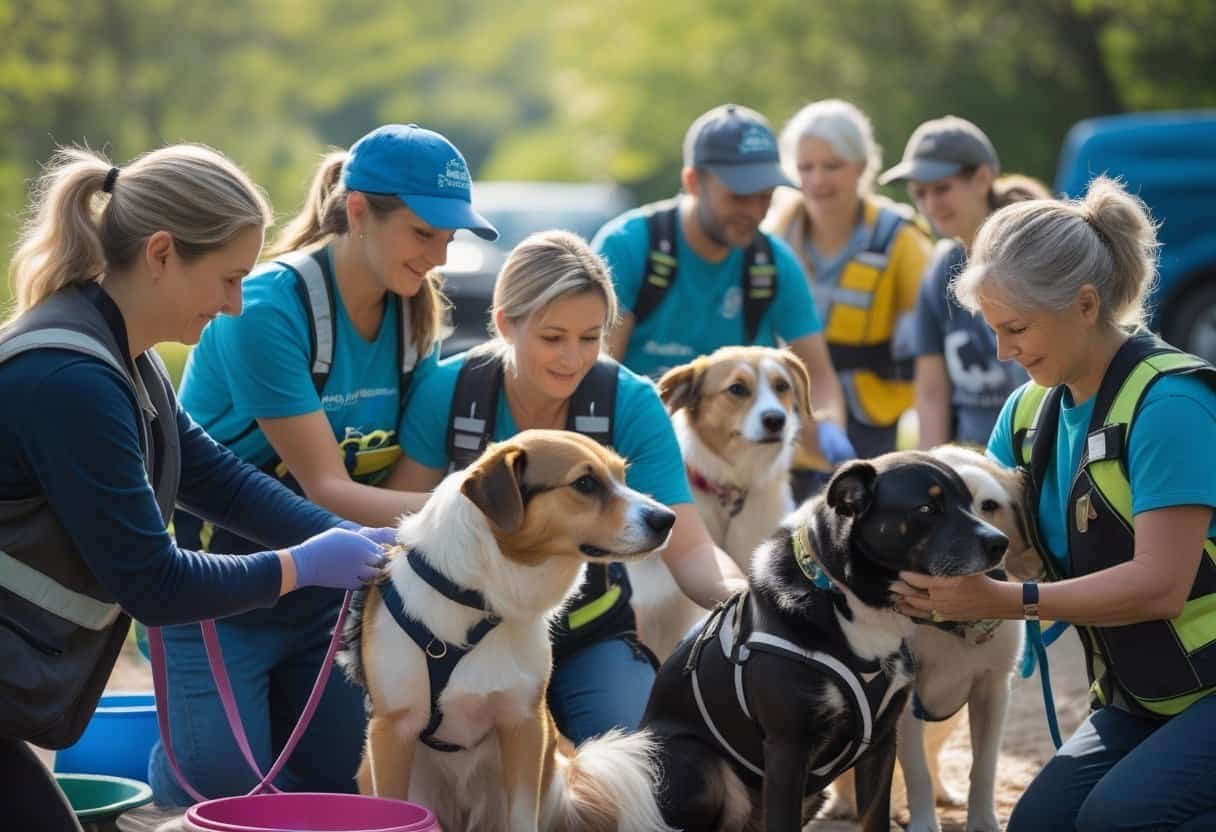
If you want to help rescue dogs, there are plenty of ways to jump in. You can give your time, your skills, or your resources to make a real difference.
Volunteer Opportunities
Volunteering is a direct way to support dog rescue. Shelters and rescue groups need people to walk dogs, clean kennels, feed, give baths, and help with admin work.
Some volunteers help at events, raising money or matching dogs with families. Fostering matters too—foster homes give dogs a safe place until they’re adopted.
Foster caregivers socialize dogs, give medicine if needed, and share updates to help dogs find permanent homes. Programs like Dogs Trust offer different volunteer roles for all kinds of interests. Find out how to support rescue dogs by volunteering with Dogs Trust.
Supporting Rescues Through Donations
Donations help rescue groups cover costs like food, vet bills, toys, collars, and shelter. Many organizations accept both money and pet supplies.
Some rescues have online wish lists or run donation drives at certain times. Giving monthly—even a little—provides steady support.
Some people donate supplies for puppies or dogs with medical needs. Most rescues list their most-needed items online.
Donors are vital since these groups often get no government funding and depend on what supporters can give. For more ideas, visit guides like this one.
Advocating for Dog Rescue
Advocacy means speaking up for rescue dogs and sharing their stories. Supporters encourage friends to adopt instead of buying from breeders, talk about spaying or neutering pets, and help others understand animal abandonment.
People who care about rescue dogs sometimes contact local officials to support animal-friendly laws. They might write letters, share messages on social media, or help rescues respond to community issues.
Advocates are key in making long-term changes that help dogs in need.
Helping Raise Awareness
Raising awareness helps more people discover rescue dogs and the work of local organizations. Even small actions—like sharing adoptable dogs online or wearing a rescue-themed shirt—can reach new supporters.
Some folks organize or join events, like adoption fairs or charity runs. These gatherings often feature flyers, presentations, and chances to meet rescue animals.
Workshops and seminars pop up at many groups, like those in this pet rescue learning guide. Getting the word out really does make a difference.
Community Education and Outreach
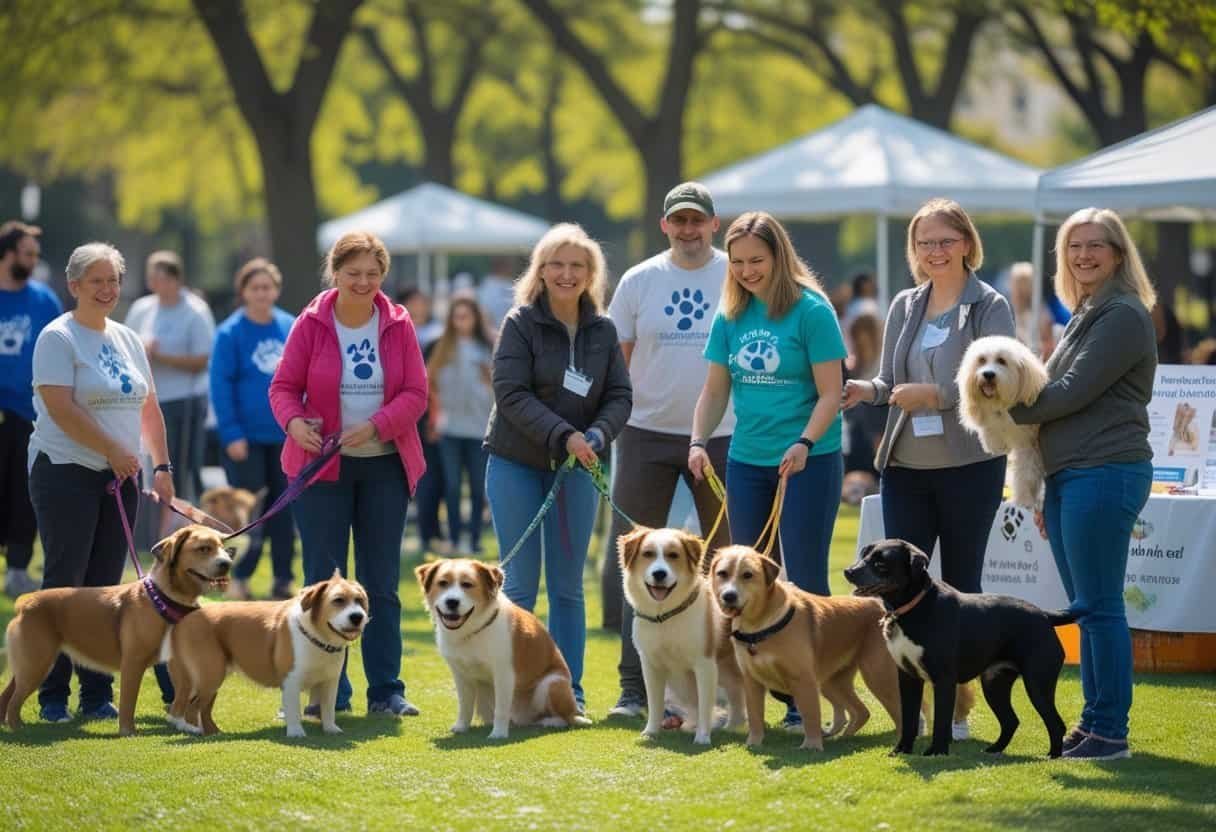
Community involvement drives successful rescue dog efforts. Shelters and local groups offer education that benefits owners, adopters, and animals.
Support comes through clear information, local programs, and resources that actually help rescue dogs. It’s not just about handing out pamphlets—real conversations and support matter.
Promoting Responsible Pet Ownership
Shelters and rescues teach pet owners about daily care and the long-term needs of their dogs. This covers feeding, grooming, exercise, vet visits, and safe home environments.
Outreach often tackles spaying and neutering, which helps control pet overpopulation. Local rescue organizations share tips through workshops, online posts, and social media.
Some communities team up with vets or trainers to offer free or low-cost clinics on vaccinations, microchipping, and pet behavior. Groups like Peace Love Rescue provide food, vet care, and info for pet owners who need a hand.
Educational Programs about Rescue
Many shelters set up school visits, join fairs, or give talks about rescue and why adopting matters. Students and families learn how rescue dogs end up in shelters and how adoption changes lives.
Reading programs, like the one at Pets4Luv, let kids read to dogs and cats. This helps socialize the animals and encourages literacy at the same time.
Volunteers sometimes lead tours or create art projects about rescue dogs to raise awareness. Information about animal welfare laws, the role of shelters, and ways to help gets shared through events and online.
Resources for New Adopters
New adopters get guidance and resources to help both the pet and family settle in. Many rescues hand out care kits with food samples, collars, vaccination records, and training tips.
Support doesn’t stop after adoption. Help lines, online forums, and follow-up check-ins offer ongoing support.
The SPCA Serving Erie County provides services like behavior advice, help with vet costs, and tips for common adjustment problems. Workshops and printed guides about dog training, medical needs, and household integration are often free.
Choosing the Right Rescue Dog
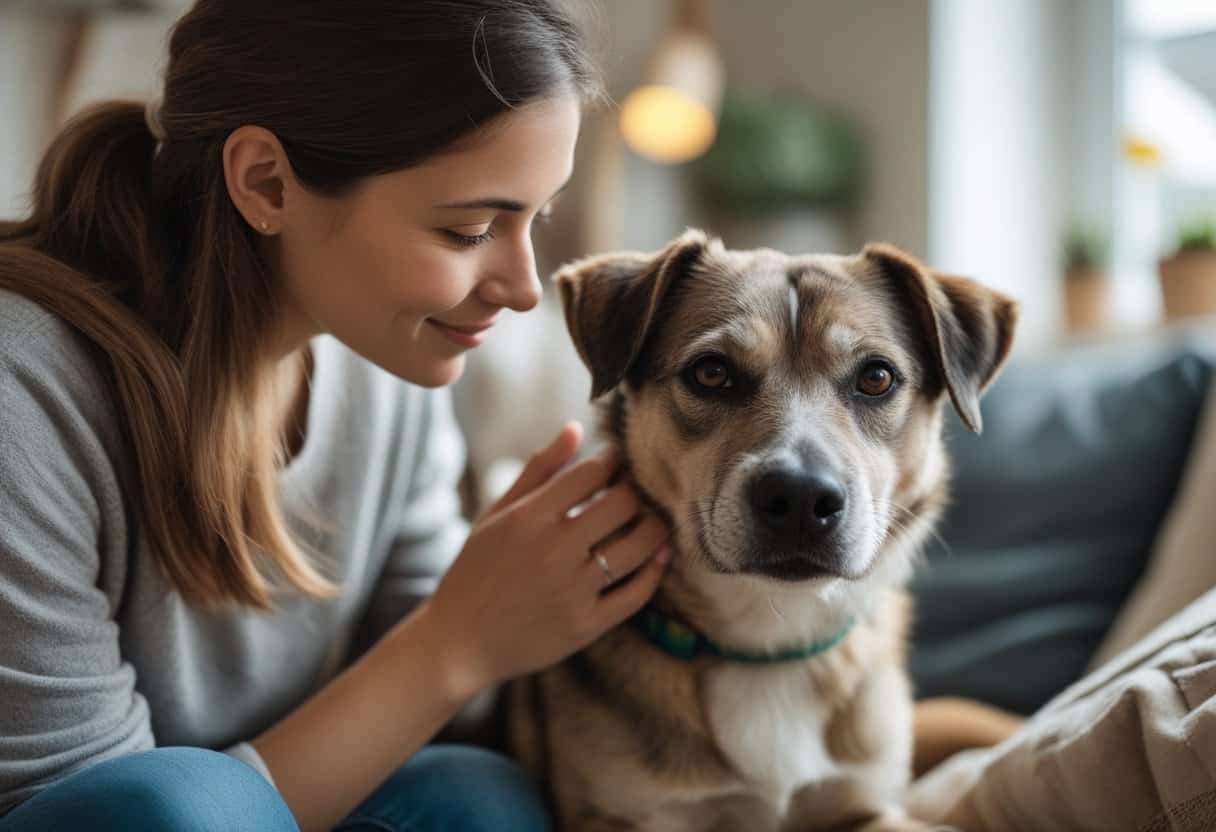
Adopting a rescue dog is a big decision. Finding the right match depends on practical steps like knowing your living situation, thinking about personality, and making sure the new dog fits in.
Assessing Your Lifestyle
Lifestyle matters a lot when choosing a rescue dog. If you’re active, a high-energy dog like a young Labrador or Border Collie might suit you.
If you’re less mobile or spend more time indoors, an older or calmer breed could be better. It helps to make a quick chart:
- How much daily exercise can I provide?
- Are there kids or other pets at home?
- Am I in an apartment or a house with a yard?
Matching energy levels and breed traits to your daily routine gives you a better shot at a smooth adoption. Calm dogs often do well with families or seniors, while energetic ones need owners who like to walk or run. More tips are at DoggySaurus on what to look for when adopting a dog.
Matching with the Perfect Rescue Dog
Shelters work to match people with the right rescue dog. Sharing details about your lifestyle helps staff recommend a good fit.
Many rescue groups specialize in matching breed, age, and temperament to your needs. The best match isn’t just about looks—it’s about personality and activity level.
Sometimes, quieter homes are best for shy dogs, while playful homes suit puppies. Local rescues help create the best adoption matches, and Adopt a Pet has a guide on how to rescue a dog.
Before you decide, spend time with different dogs at the shelter. Ask about behavior, background, and health needs.
Integrating a Rescue Dog into Your Home
Bringing home a rescue dog takes patience. Instead of introducing them to everyone right away, let them settle into the main living area first.
Stick to a routine for meals, walks, and rest. Set up a quiet space with a bed, water, and toys.
Use positive reinforcement to help your dog feel safe. Watch for stress signs, like hiding or barking, and give the dog space if needed.
Introduce family members and pets slowly. Short, gentle walks help build trust.
Avoid parties or crowded places at first. Too much too soon can overwhelm your new dog. For more tips, visit Canine Weekly on choosing a rescue dog at the shelter.
Challenges and Solutions in Dog Rescue
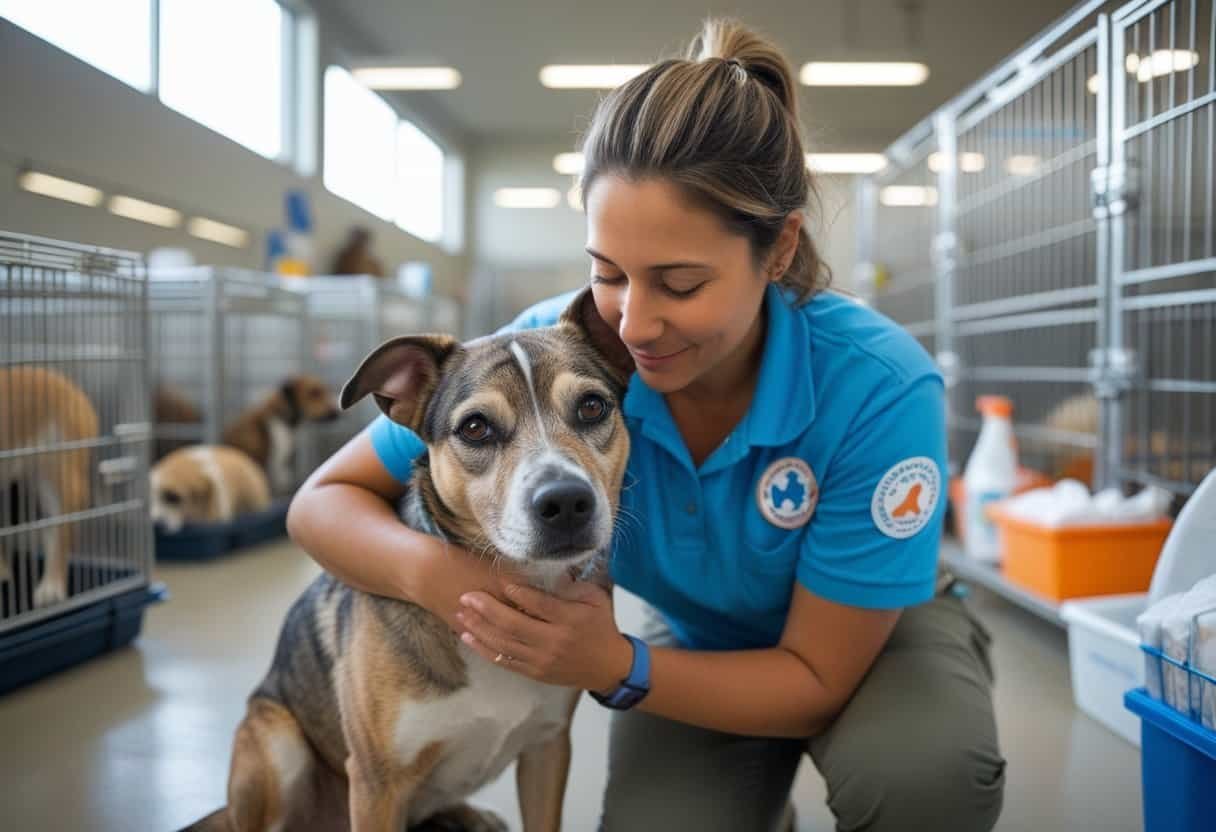
Rescue dogs can face unique obstacles after adoption, like tough behaviors or emotional needs. Working through these challenges supports their well-being and helps both dog and adopter.
Overcoming Behavioral Issues
Many rescue dogs show fear, anxiety, or even aggression—often from past trauma or little socialization. You might see food aggression, resource guarding, or leash reactivity.
These behaviors can cause stress at home. A daily routine helps your dog feel secure.
Consistency in feeding, walks, and play builds trust. For tough behaviors, positive reinforcement training works well.
Sometimes you’ll need a professional trainer or behavior specialist, especially for aggression or reactivity. Patience matters—some dogs need weeks, others months, to adjust. Check out WideOpenSpaces for more on food guarding and other issues.
Supporting High-Needs Dogs
Some rescue dogs have special medical, emotional, or behavioral needs. Seniors, dogs with chronic illness, or those neglected long-term need extra attention.
Regular vet visits matter for ongoing care and rehab. Some high-needs dogs do best with tailored exercise and a low-stress home.
Simple comforts, like a quiet spot and cozy bed, help them settle. Sometimes therapy or medication is necessary for severe anxiety or trauma.
Support groups and online communities offer tips and encouragement. For more strategies, check out AllThingsCanid.org.
Addressing Stigma Around Rescue Dogs
Rescue dogs deal with unfair stereotypes—like being “damaged” or too aggressive. This stigma hurts their adoption chances and can put families off.
Education helps shift these beliefs. Rescue organizations share success stories and host public events where people meet well-adjusted dogs.
Being open about a dog’s history and progress builds trust with adopters. Shelters now use professional assessments to match dogs with the right families.
Read more about stigma and adoption at DogTagArt.
Frequently Asked Questions

Adopting a rescue dog involves several important steps. Knowing what to expect makes things smoother for both people and pets.
What should I consider before adopting a rescue dog?
Think about your lifestyle, home setup, and how much time you can give a dog. Also consider the dog’s age, energy level, and any special needs they might have.
Rescue dogs sometimes need extra patience and training. Many have experienced stress or trauma before.
How can I find reputable dog rescue organizations in my area?
Look for rescues that are open about their process and have good reviews. Many provide detailed info about their dogs and make sure animals are fully vetted.
Websites like Rescue Dogs 101 and Redemption Paws offer helpful questions and info about trusted rescues.
What are the most common challenges when adopting a large breed dog from a rescue?
Large breeds need more space and exercise, and sometimes stronger management skills. They often have higher food and medical costs.
Some big rescue dogs haven’t been well socialized and might be stronger or more energetic than you expect. This can cause leash training issues or challenges with new environments.
What is the process for adopting a dog from a rescue organization?
Usually, you fill out an application, do an interview, and sometimes have a home visit. Many rescues use foster homes, so you might meet the dog in a private home.
If approved, you’ll pay an adoption fee and sign paperwork before bringing your new dog home. Details can vary, as Fluffy Dog Rescue explains.
How can I prepare my home for a newly adopted rescue dog?
Secure your space to prevent escapes and remove things a dog might chew or swallow. Set up a quiet, comfy spot for rest.
Have food, water, a collar, leash, and toys ready. Give your new dog time to settle in and be patient as they adjust.
A calm environment helps them feel safe, especially those first few days.
What are the typical fees associated with adopting a dog from a rescue?
Most rescue organizations charge an adoption fee. This helps cover things like vaccinations, spay or neuter surgery, microchipping, and other basic veterinary care.
Fees usually fall somewhere between $150 and $500. The exact amount depends on the dog’s age, breed, and where the rescue is located.
Some rescues throw in starter supplies or offer post-adoption support as part of the deal. It’s a good idea to ask what the fee actually covers before you make your decision.
Ready to Adopt a Poodle?
Find poodle rescues and adoption organizations near you. Give a loving poodle their forever home.







